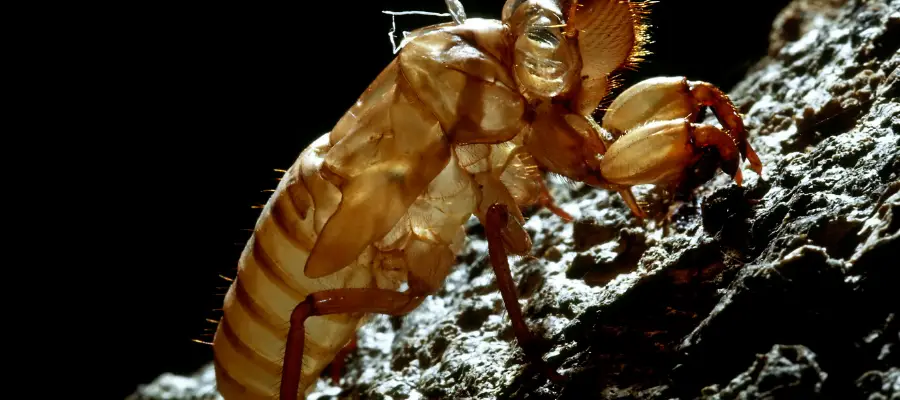Have you ever wondered how long Cicadas live? As tiny as they are, the Cicadas aerate the soil, prune mature trees and provide nitrogen for growing plants when they die.
Here is what you need to know:
Periodical Cicadas can live for 13 to 17 years underground while the annual cicadas live for 2 to 5 years
After mating, the Cicadas live for 2-6 weeks.
Cicadas are known to have the longest life cycle of any insect. Such a big difference with butterflies!
Species Overview of the Cicadas
Before we dive into the lifespan of Cicadas, here is an overview of Cicadas.
The cicadas are a superfamily in the line of insects known as true bugs. They are in the subfamily together with smaller jumping bugs such as froghoppers and leafhoppers.
There are more than 3,000 species described from around the world leaving many undescribed.
Cicadas are well known for their exceptionally loud singing. This is produced in most species by the two vibrating membranes called tymbals that sit on the male cicada’s abdomen. Only male cicadas can sing.
These insects naturally live on trees, feeding on the watery sap. The female cicadas lay their eggs in a slit in the bark of trees.
The cicadas camouflage to their environment to avoid predators. The large ones can fly rapidly when disturbed and other species simply play dead when threatened.
Most cicada species are active during the day as adults. A few species of cicadas call at dawn or dusk. Rare few species are known to be active at night.
Adult cicadas are mostly eaten by birds, squirrels, wasps, bats, mantises, and spiders.
How long do Cicadas live?
The lifespan of Cicadas varies with species. The annual cicadas live for 2 to 5 years while the periodical cicadas can live for 13 or 17 years underground (as nymphs) if left undisturbed.
They are known to have the longest lifespan of all insects. [1]
How long do Cicadas live underground?

The Periodical Cicadas live anywhere from 13-17 years underground while the Annual Cicadas live 2-5 years underground.
The Cicada nymphs have to go through four molting stages while underground. Each molt changes them in different ways.
The fifth which is the final molt usually occurs above the ground. This stage gives cicadas the ability to fly.
Once they dig themselves from the ground, cicadas climb trees such as fresh hardwood and shrubs that are nearby and shed off their skin.
After hibernating from the ground, their exoskeletons are now fully hardened and they begin a month-long process of mating.
When the time is ripe for the periodical cicadas to emerge, all the nymphs in a specific location will appear around the same time. A single acre can have more than 1.5 million cicadas clustered. A group of periodical cicadas who emerge at the same time and cycle is called a brood. [2]
When soil temperatures reach about 18 degrees Celsius at a depth of 12 to 18 inches, it triggers the emergence of cicadas.
Male cicadas normally emerge first then the females follow a few days later. The females are unique as they have a pointed abdomen and sheathed ovipositor used to lay eggs.
How long do Cicadas live above the ground?

Cicadas live for 5 to 6 weeks above ground.
The Cicadas’ lifespan above ground is way shorter than their underground lives. This is primarily due to a lot of time spent underground where they are still active as wingless nymphs feeding on tree saps.
Once they emerge above the ground, the male cicada’s life consists mainly of flying, singing, and mating. The song that we hear in the air a few days after the cicadas emerge is that of males making mating calls to the female cicadas. Male and female cicadas usually mate continuously with many partners.
How long do Cicadas live after mating?

Cicadas live 2-6 weeks after mating.
After the cicadas’ mating, the eggs are fertilized and the female cicadas looks for branches to lay the eggs in. The female cicada has a sharp egg-laying tube off her back end which allows her to create slits in branches. She deposits roughly 500 eggs.
Once the female cicada has finished this process, she allows herself to fall off the branch and this fall mostly kills her. Sometimes she can survive the fall but due to the strenuous exercise or being attacked by a predator, they will eventually die.
Interestingly enough, male cicadas will usually live just a few days longer.
Cicadas’ life span after they hatch
The newly hatched cicadas chew on the branch tips of the trees that they are in. This causes the branches to fall off thus carrying the young cicadas back to the soil. The process starts all over again as they will spend the next 17 years underground as a nymph.
Conclusion
The 17-year cicada life span is a rarity in the insect and even animal world at large. It’s believed that the long time spent by cicadas in the ground allows them to avoid predators during the nymph stage. The nymph stage is quite sensitive so they should develop properly without any interference.
Cicadas are very unique and interesting insects. Even above the ground, they have no natural inclination to fear predators, hence why they are easily killed by predators.
They are not afraid of human beings and are seen flying all over around us.
The one-month-long mating season of 17-year cicadas may seem like an annoyance to most humans but, animals love this golden opportunity as they will feed on a plentiful and easily catchable food source.
Unfortunately, there is a fungus that has evolved to specifically feed on dormant cicadas (nymphs). We have many different fungal diseases that infect and kill grown cicadas as well.
Next Read:


